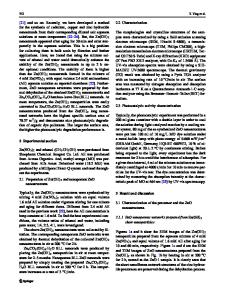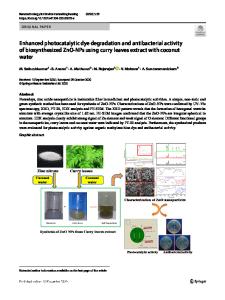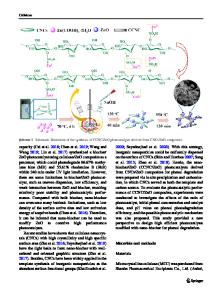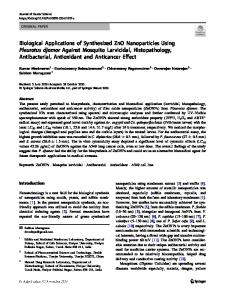Photocatalytic degradation of p-nitrophenol using biologically synthesized ZnO nanoparticles
- PDF / 4,422,964 Bytes
- 12 Pages / 595.276 x 790.866 pts Page_size
- 87 Downloads / 441 Views
ENVIRONMENTAL AND ENERGY MANAGEMENT
Photocatalytic degradation of p-nitrophenol using biologically synthesized ZnO nanoparticles Vrushali Vinayak Kadam 1 & Soundharya Dharshini Shanmugam 2 & Jagadeeshbabu Ponnan Ettiyappan 1 & Raj Mohan Balakrishnan 1 Received: 7 January 2020 / Accepted: 13 September 2020 # Springer-Verlag GmbH Germany, part of Springer Nature 2020
Abstract The present work deals with the photocatalytic degradation of p-nitrophenol as it is a United States Environmental Protection Agency-listed priority pollutant and has adverse environmental and health effects. To eradicate the detrimental environmental impact of p-nitrophenol, the biologically synthesized ZnO nanoparticles were used as a photocatalyst. The degradation of pnitrophenol was confirmed by decreasing the absorbance value at a characteristic wavelength of 317 nm using the UV-vis spectrophotometer. Reaction parameters such as ZnO photocatalyst concentration of 0.1 g/L at pH 11 in the presence of H2O2 (5 mM) were found to be optimum conditions for p-nitrophenol degradation. The photocatalytic degradation was slowly enhanced in the presence of H2O2 as an electron acceptor. The kinetics of nitrophenol degradation was studied, which follows the pseudo-first-order reaction. The photocatalytic degradation of p-nitrophenol was characterized by using total organic carbon, chemical oxygen demand, and high-performance liquid chromatography analyses. This method is found to be effective as it is environmentally friendly, free of toxic chemicals. Keywords Biosynthesis . Photocatalytic degradation . p-Nitrophenol . UV irradiation . ZnO nanoparticles
Introduction Nitroaromatics such as o-nitrophenol (2-nitrophenol), mnitrophenol (3-nitrophenol), and p-nitrophenol (4-nitrophenol)
Responsible editor: Philippe Garrigues Electronic supplementary material The online version of this article (https://doi.org/10.1007/s11356-020-10833-w) contains supplementary material, which is available to authorized users. * Raj Mohan Balakrishnan [email protected]; [email protected] Vrushali Vinayak Kadam [email protected] Soundharya Dharshini Shanmugam [email protected] Jagadeeshbabu Ponnan Ettiyappan [email protected] 1
Department of Chemical Engineering, National Institute of Technology, Surathkal, Karnataka 575025, India
2
Department of Chemical Engineering, Kongu Engineering College, Erode, Tamil Nadu 638052, India
are used as an industrially essential raw material and intermediate compounds in the production of pesticides, dyes, pharmaceuticals, and explosives (Din et al. 2019; ATSDR 1992). pNitrophenol became persistent in the environment due to anthropogenic activity, bioaccumulation ability, and stability, which can cause contamination of soil, air, and groundwater. The exposure of untreated industrial effluent leads to deterioration of the environment and poses a threat to human health. The acute toxicity of p-nitrophenol leads to methemoglobin formation, corneal opacity chromosomal aberrations, drowsiness, eye irritation,
Data Loading...











